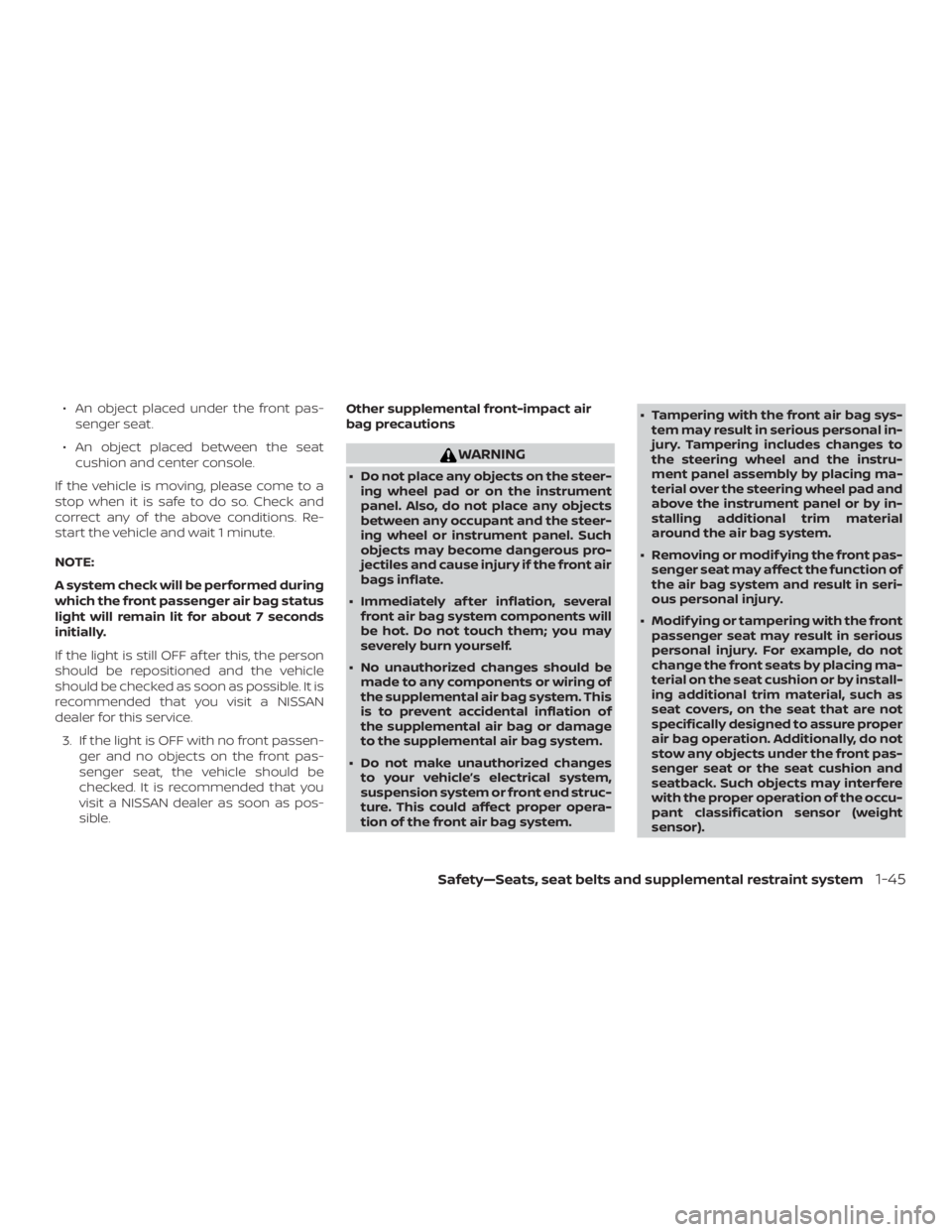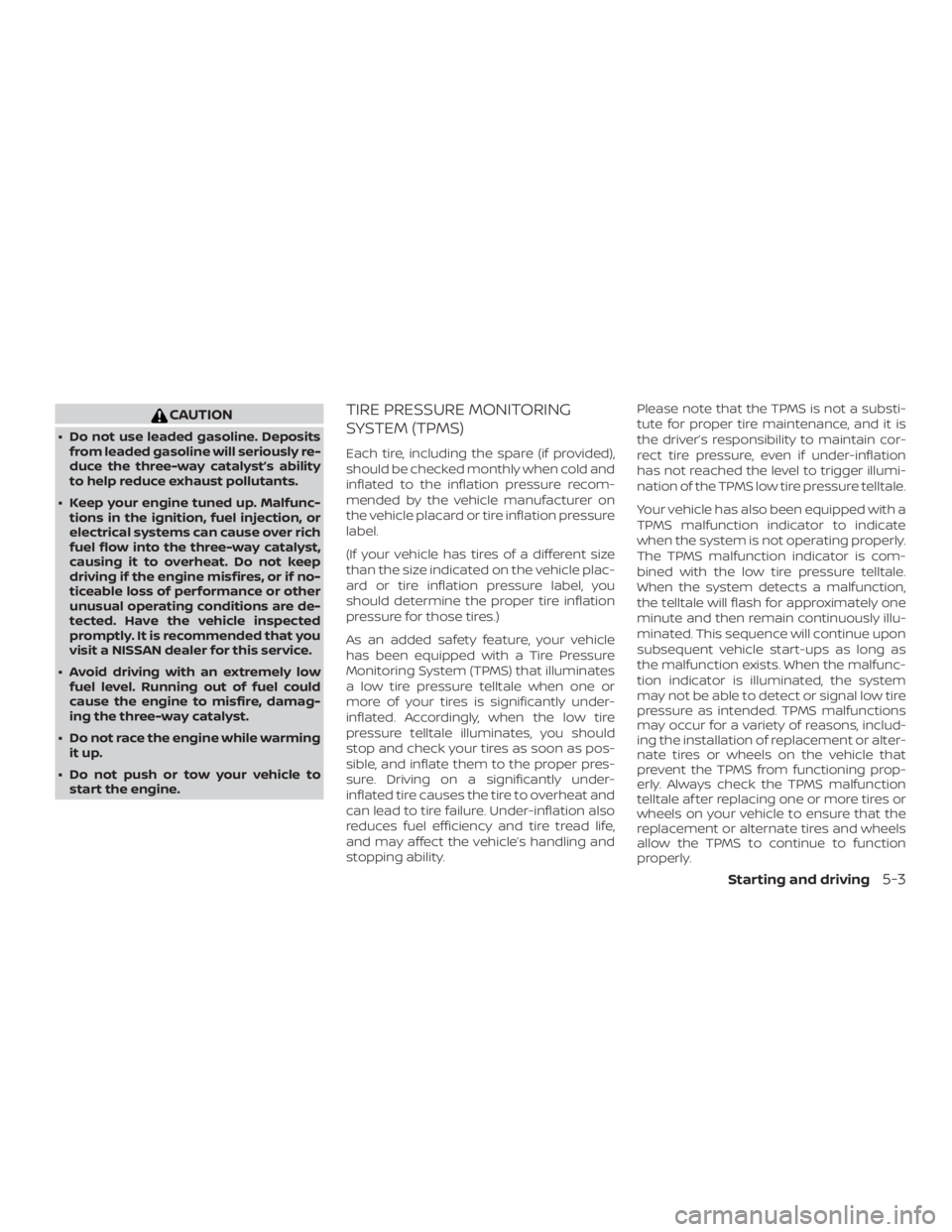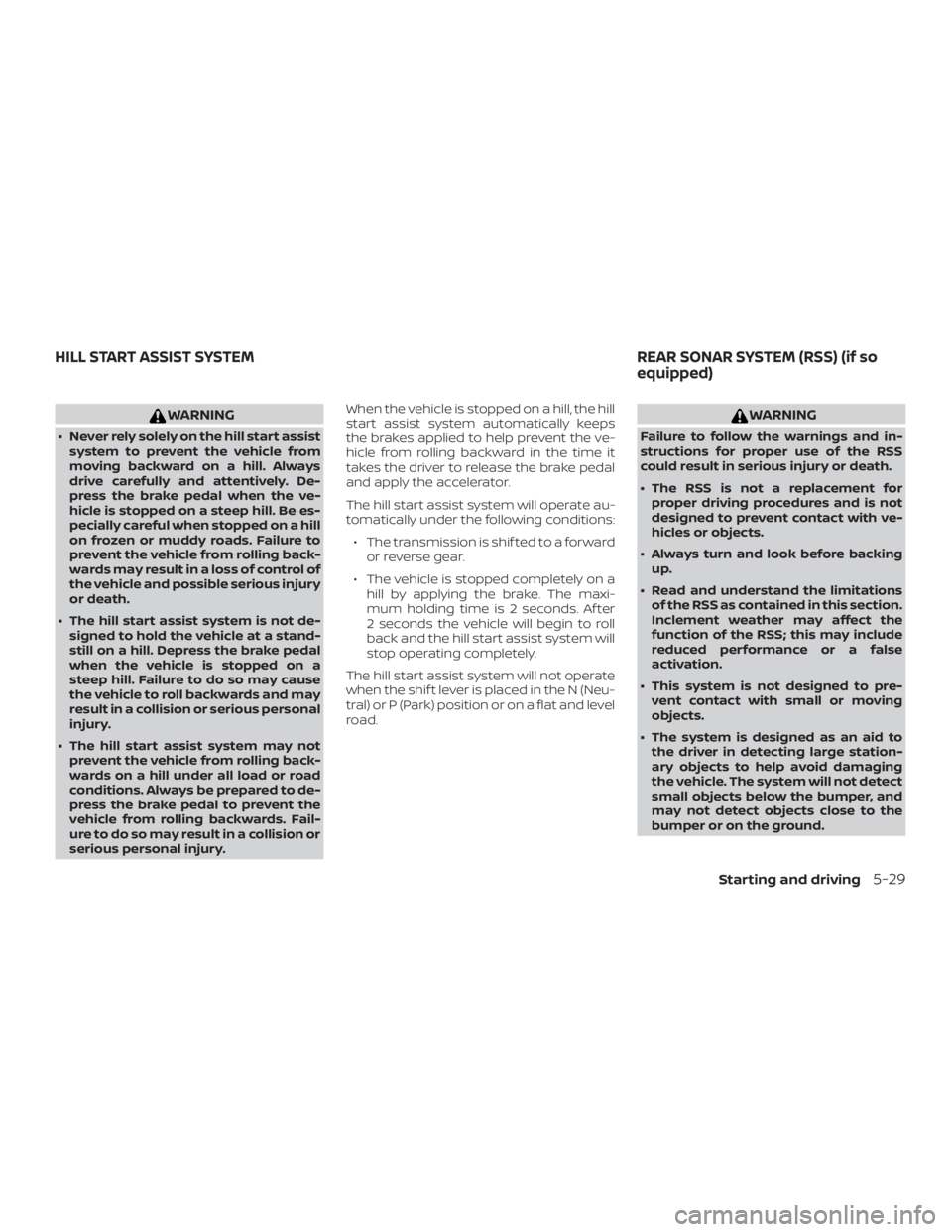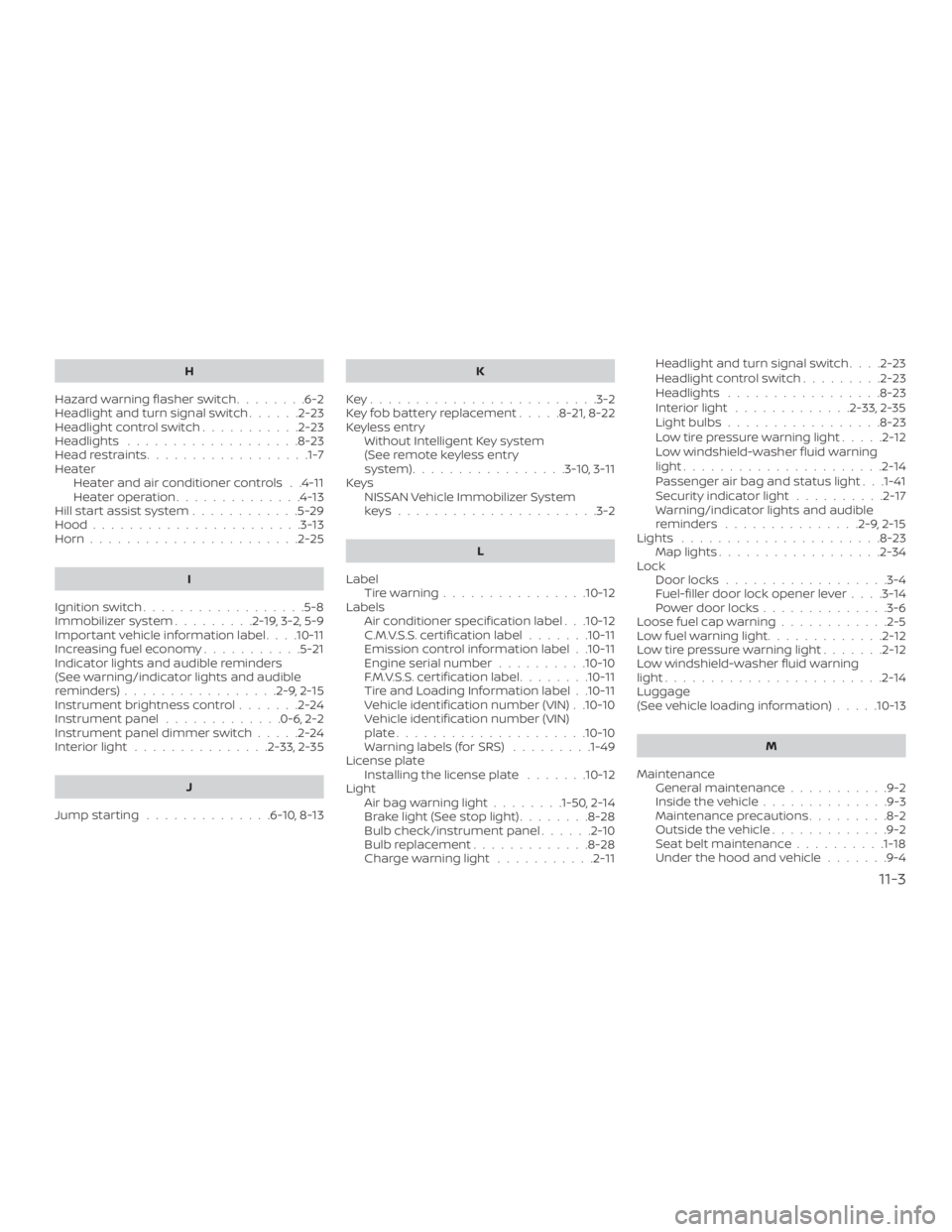2020 NISSAN NV200 stop start
[x] Cancel search: stop startPage 65 of 300

∙ An object placed under the front pas-senger seat.
∙ An object placed between the seat cushion and center console.
If the vehicle is moving, please come to a
stop when it is safe to do so. Check and
correct any of the above conditions. Re-
start the vehicle and wait 1 minute.
NOTE:
A system check will be performed during
which the front passenger air bag status
light will remain lit for about 7 seconds
initially.
If the light is still OFF af ter this, the person
should be repositioned and the vehicle
should be checked as soon as possible. It is
recommended that you visit a NISSAN
dealer for this service. 3. If the light is OFF with no front passen- ger and no objects on the front pas-
senger seat, the vehicle should be
checked. It is recommended that you
visit a NISSAN dealer as soon as pos-
sible. Other supplemental front-impact air
bag precautions
Page 153 of 300

CAUTION
∙ Do not use leaded gasoline. Depositsfrom leaded gasoline will seriously re-
duce the three-way catalyst’s ability
to help reduce exhaust pollutants.
∙ Keep your engine tuned up. Malfunc- tions in the ignition, fuel injection, or
electrical systems can cause over rich
fuel flow into the three-way catalyst,
causing it to overheat. Do not keep
driving if the engine misfires, or if no-
ticeable loss of performance or other
unusual operating conditions are de-
tected. Have the vehicle inspected
promptly. It is recommended that you
visit a NISSAN dealer for this service.
∙ Avoid driving with an extremely low fuel level. Running out of fuel could
cause the engine to misfire, damag-
ing the three-way catalyst.
∙ Do not race the engine while warming it up.
∙ Do not push or tow your vehicle to start the engine.
TIRE PRESSURE MONITORING
SYSTEM (TPMS)
Each tire, including the spare (if provided),
should be checked monthly when cold and
inflated to the inflation pressure recom-
mended by the vehicle manufacturer on
the vehicle placard or tire inflation pressure
label.
(If your vehicle has tires of a different size
than the size indicated on the vehicle plac-
ard or tire inflation pressure label, you
should determine the proper tire inflation
pressure for those tires.)
As an added safety feature, your vehicle
has been equipped with a Tire Pressure
Monitoring System (TPMS) that illuminates
a low tire pressure telltale when one or
more of your tires is significantly under-
inflated. Accordingly, when the low tire
pressure telltale illuminates, you should
stop and check your tires as soon as pos-
sible, and inflate them to the proper pres-
sure. Driving on a significantly under-
inflated tire causes the tire to overheat and
can lead to tire failure. Under-inflation also
reduces fuel efficiency and tire tread life,
and may affect the vehicle’s handling and
stopping ability. Please note that the TPMS is not a substi-
tute for proper tire maintenance, and it is
the driver’s responsibility to maintain cor-
rect tire pressure, even if under-inflation
has not reached the level to trigger illumi-
nation of the TPMS low tire pressure telltale.
Your vehicle has also been equipped with a
TPMS malfunction indicator to indicate
when the system is not operating properly.
The TPMS malfunction indicator is com-
bined with the low tire pressure telltale.
When the system detects a malfunction,
the telltale will flash for approximately one
minute and then remain continuously illu-
minated. This sequence will continue upon
subsequent vehicle start-ups as long as
the malfunction exists. When the malfunc-
tion indicator is illuminated, the system
may not be able to detect or signal low tire
pressure as intended. TPMS malfunctions
may occur for a variety of reasons, includ-
ing the installation of replacement or alter-
nate tires or wheels on the vehicle that
prevent the TPMS from functioning prop-
erly. Always check the TPMS malfunction
telltale af ter replacing one or more tires or
wheels on your vehicle to ensure that the
replacement or alternate tires and wheels
allow the TPMS to continue to function
properly.
Starting and driving5-3
Page 179 of 300

WARNING
∙ Never rely solely on the hill start assistsystem to prevent the vehicle from
moving backward on a hill. Always
drive carefully and attentively. De-
press the brake pedal when the ve-
hicle is stopped on a steep hill. Be es-
pecially careful when stopped on a hill
on frozen or muddy roads. Failure to
prevent the vehicle from rolling back-
wards may result in a loss of control of
the vehicle and possible serious injury
or death.
∙ The hill start assist system is not de- signed to hold the vehicle at a stand-
still on a hill. Depress the brake pedal
when the vehicle is stopped on a
steep hill. Failure to do so may cause
the vehicle to roll backwards and may
result in a collision or serious personal
injury.
∙ The hill start assist system may not prevent the vehicle from rolling back-
wards on a hill under all load or road
conditions. Always be prepared to de-
press the brake pedal to prevent the
vehicle from rolling backwards. Fail-
ure to do so may result in a collision or
serious personal injury. When the vehicle is stopped on a hill, the hill
start assist system automatically keeps
the brakes applied to help prevent the ve-
hicle from rolling backward in the time it
takes the driver to release the brake pedal
and apply the accelerator.
The hill start assist system will operate au-
tomatically under the following conditions:
∙ The transmission is shif ted to a forward or reverse gear.
∙ The vehicle is stopped completely on a hill by applying the brake. The maxi-
mum holding time is 2 seconds. Af ter
2 seconds the vehicle will begin to roll
back and the hill start assist system will
stop operating completely.
The hill start assist system will not operate
when the shif t lever is placed in the N (Neu-
tral) or P (Park) position or on a flat and level
road.
Page 291 of 300

H
Hazard warning flasher switch ........6-2
Headlight and turn signal switch ......2-23
Headlightcontrolswitch...........2-23
Headlights ...................8-23
Headrestraints................. .1-7
Heater Heater and air conditioner controls . .4-11
Heater operation ..............4-13
Hill start assist system ............5-29
Hood .......................3-13
Horn.......................2-25
I
Ignition switch ..................5-8
Immobilizer system .........2-19,3-2,5-9
Important vehicle information label . . . .10-11
Increasing fuel economy ...........5-21
Indicator lights and audible reminders
(See warning/indicator lights and audible
reminders) .................2-9,2-15
Instrument brightness control .......2-24
Instrument panel .............0-6,2-2
Instrument panel dimmer switch .....2-24
Interiorlight ...............2-33,2-35
J
Jumpstarting ..............6-10,8-13 K
Key........................ .3-2
Key fob battery replacement .....8-21,8-22
Keyless entry Without Intelligent Key system
(See remote keyless entry
system) .................3-10,3-11
Keys NISSAN Vehicle Immobilizer System
keys......................3-2
L
Label Tirewarning................10-12
Labels Air conditioner specification label . . .10-12
C.M.V.S.S. certification label .......10-11
Emission control information label . .10-11
Engine serial number ..........10-10
F.M.V.S.S. certification label ........10-11
Tire and Loading Information label . .10-11
Vehicle identification number (VIN) . .10-10
Vehicle identification number (VIN)
plate.....................10-10
Warning labels (for SRS) .........1-49
License plate Installing the license plate .......10-12
Light Airbagwarninglight........1-50, 2-14
Brakelight(Seestoplight)........8-28
Bulb check/instrument panel ......2-10
Bulb replacement .............8-28
Charge warning light ...........2-11 Headlight and turn signal switch
. . . .2-23
Headlightcontrolswitch.........2-23
Headlights .................8-23
Interiorlight .............2-33,2-35
Lightbulbs.................8-23
Lowtirepressurewarninglight.....2-12
Low windshield-washer fluid warning
light......................2-14
Passenger air bag and status light . . .1-41
Security indicator light ..........2-17
Warning/indicator lights and audible
reminders ...............2-9, 2-15
Lights ......................8-23 Maplights................. .2-34
Lock Door locks ..................3-4
Fuel-filler door lock opener lever ....3-14
Power door locks ..............3-6
Loose fuel cap warning ............2-5
Lowfuelwarninglight.............2-12
Low tire pressure warning light .......2-12
Low windshield-washer fluid warning
light........................2-14
Luggage
(See vehicle loading information) .....10-13
M
Maintenance General maintenance ...........9-2
Insidethevehicle..............9-3
Maintenanc
e precautions .........8-2
Outsidethevehicle.............9-2
Seat belt maintenance ..........1-18
Under the hood and vehicle .......9-4
11-3
Page 293 of 300

Seat belt extenders............1-18
Seat belt maintenance ..........1-18
Seatbelts................1-11, 7-6
Shoulder belt height adjustment . . . .1-17
Three-pointtypewithretractor.....1-14
Seat belt extenders ..............1-18
Seatbeltwarninglight.........1-14, 2-14
Seats Adjustment ..................1-2
Frontseats..................1-2
Manual front seat adjustment ......1-3
Seats/floormats................7-5
Security indicator light ............2-17
Security system (NISSAN Vehicle Immobilizer
System), engine start ..........2-19,5-9
Security systems Vehicle security system .........2-18
Self-adjustingbrakes.............8-17
Service manual order form .........10-22
Servicing air conditioner ...........4-19
Shif ting Continuously Variable Transmission
(CVT) .....................5-14
Shoulder belt height adjustment ......1-17
Sliding door Manual sliding door .............3-7
Sonar Rear system ................5-29
Spark plug replacement ...........8-15
Spark plugs ...................8-15
Specifications .................10-8
Speedometer ..................2-4
SRS warning label ...............1-49
Stability control ................5-26
Standard maintenance ..........9-7,9-8 Starting
Before starting the engine ........5-10
Jumpstarting ............6-10,8-13
Precautions when starting and
driving.....................5-2
Push starting ................6-12
Starting the engine ............5-10
Starting the engine ..............5-10
Steering Power steering system ..........5-23
Stoplight....................8-28
Storage.....................2-28 D-ring ....................2-30
Storagetray...............2-28,2-29
Sunvisors....................3-17
Supplemental air bag warning labels . . .1-49
Supplemental air bag warning
light.................... .1-50, 2-14
Supplemental front impact air bag
system ..................... .1-39
Supplemental restraint system Information and warning labels . . . .1-49
Precautions on supplemental restraint
system ................... .1-32
Supplemental restraint system
(Supplemental air bag system) .......1-32
Switch Automatic power window switch . . .2-32
Hazard warning flasher switch ......6-2
Headlight and turn signal switch ....2-23
Headlightcontrolswitch.........2-23
Ignition switch ................5-8
Instrument brightness control .....2-24
P
ower door lock switch ..........3-6
Rear sonar system OFF switch .....2-26Rear window and outside mirror
defrosterswitch..............2-22
Turn signal switch
.............2-25
T
Tachometer ...................2-6
Thef t (NISSAN Vehicle Immobilizer System),
engine start ................2-19,5-9
Three-waycatalyst...............5-2
Tire Flattire..................6-2,6-3
Spare tire ...................6-4
Tire and Loading Information label . .10-11
Tire chains .................8-38
Tirepressure.............8-31,8-31
Tirerotation ................8-38
Typesoftires................8-37
Uniform tire quality grading ......10-18
Wheels and tires ...........8-31,10-9
Wheel/tire size ...............10-9
Tire pressure Lowtirepressurewarninglight.....2-12
Tire Pressure Monitoring System (TPMS) . .5-3
Tire warning label ...............10-12
Toptetherstrapchildrestraint.......1-23
Towing 4-wheel drive models ...........6-14
Flattowing.................10-17
Towtrucktowing .............6-13
Trailertowing ...............10-17
Towingatrailer................10-17
Transmission Continuously Variable Transmission
(CVT) fluid ..................8-10
11-5